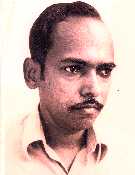

Home | Biodata | Biography | Photo Gallery | Publications | Tributes
Character Recognition

 |

Home | Biodata | Biography | Photo Gallery | Publications | Tributes Character Recognition |
 |
Dr. Gift Siromoney had varied interests  from archaeology to Theoretical Computer Science. He believed more
in application than in theory. As Newton discovered the gravitational
force by observing an apple falling down, Dr. Gift always started from the
application and proposed theory based on that. Dr.Gift Siromoney, Dr.M.Chandrasekaran, and myself were travelling from Tambaram by an
electric train to catch a train to Calcutta to attend an International
Conference on Recent Trends and Developments in Pattern Recognition held at
the Indian Statistical Institute in the year 1977. When nearing Pallavaram
Hills, Dr. Gift Siromoney had hit upon a novel method of feature extraction from
two-level digital pictures containing 0's for the background and 1's for the
area covered by the letter, which he immediately told us. During the travel from
Chennai Central to Howrah, we had almost finalized the procedure in the train
itself. He said that the machine should be made to work like a machine. He
proposed a scheme of encoding rows and columns in two-level digital pictures in
terms of the number of runs of 1's. This resulted in a pair of feature strings
for a digital picture. Normally, in pattern recognition problems, thinning the
given pattern is carried out as a preprocessing method, before the feature
extraction takes place. However, condensing or shrinking the feature string by
replacing a substring of a symbol by a single occurrence of that symbol, really
made the condensed feature strings independent of magnification and elongation
of the digital pictures. This invariant property was very useful in recognizing
various characters belonging to different languages. Whenever ties were
observed, they were resolved by considering special coding schemes for the rows
and columns that had a single run of 1's. This method of encoding two-level
digital pictures resulted in a pair of very small strings, one corresponding to
the rows and the other to columns, called 'The Condensed Run Method'.
from archaeology to Theoretical Computer Science. He believed more
in application than in theory. As Newton discovered the gravitational
force by observing an apple falling down, Dr. Gift always started from the
application and proposed theory based on that. Dr.Gift Siromoney, Dr.M.Chandrasekaran, and myself were travelling from Tambaram by an
electric train to catch a train to Calcutta to attend an International
Conference on Recent Trends and Developments in Pattern Recognition held at
the Indian Statistical Institute in the year 1977. When nearing Pallavaram
Hills, Dr. Gift Siromoney had hit upon a novel method of feature extraction from
two-level digital pictures containing 0's for the background and 1's for the
area covered by the letter, which he immediately told us. During the travel from
Chennai Central to Howrah, we had almost finalized the procedure in the train
itself. He said that the machine should be made to work like a machine. He
proposed a scheme of encoding rows and columns in two-level digital pictures in
terms of the number of runs of 1's. This resulted in a pair of feature strings
for a digital picture. Normally, in pattern recognition problems, thinning the
given pattern is carried out as a preprocessing method, before the feature
extraction takes place. However, condensing or shrinking the feature string by
replacing a substring of a symbol by a single occurrence of that symbol, really
made the condensed feature strings independent of magnification and elongation
of the digital pictures. This invariant property was very useful in recognizing
various characters belonging to different languages. Whenever ties were
observed, they were resolved by considering special coding schemes for the rows
and columns that had a single run of 1's. This method of encoding two-level
digital pictures resulted in a pair of very small strings, one corresponding to
the rows and the other to columns, called 'The Condensed Run Method'.
The Condensed Run Methods were successfully applied first to the Printed Tamil Characters, and then to the characters belonging to multiple fonts. The subsequent study of the problem of hand-printed characters met with great success. Later, the problems of computer recognition of printed numerals and automatic recognition of printed
mridangam (a leather-based musical drum) mnemonics were taken up and solved. As we were also working on the ancient Tamil writings during that period, computer recognition of an ancient Chola script of the medieval period was considered and implemented. After that, character recognition of the Brahmi script (circa 300 B.C.) was taken up and completed. The department of Electronics Commission of India sanctioned a project to implement the automatic recognition of Tamil, Malayalam and
Devanagari scripts which was successfully completed. Apart from pattern recognition, dating of medieval Tamil inscriptions and writer identification were also taken up for study.
- R. Chandrasekaran (B.Sc. and M.Sc. 1972-76, Ph.D, 1982)
Current Affiliation: Professor, Department of Statistics, Madras Christian College.
